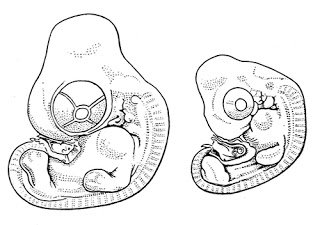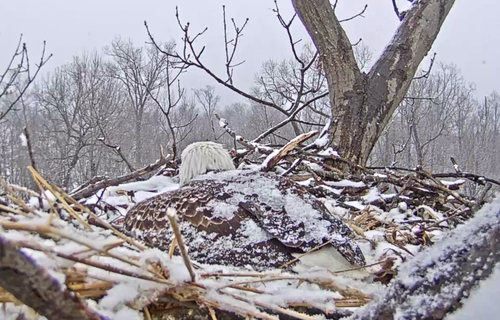Hanover Bald Eagle Blog # 14
In partnership with Pennsylvania Game Commission and Comcast Business .
Last Friday evening the second egg of the clutch was laid! Both embryos have now been developing for at least a week, and the first-born should be on the verge of looking somewhat bird-like. While a 9-day old chick doesn’t look convincingly avian, by day 11 the beak and limbs appear more formed, and the eyelids begin closing. Though veiled from our eyes, each day these little chicks are developing more and more eagle characteristics, all made possible by the very crucial parental behavior of incubation.

Throughout the week we have seen Liberty and Freedom sharing the responsibility of incubation, maintaining admirable vigilance even through snowstorms and bitter winds. Occasionally, however, the eggs are left exposed. With such cold temperatures this may seem like a risky parental decision, but have no fear: the embryos of most bird species including bald eagles are remarkably resilient and both males and female bald eagles have a brood patch fully equipped with temperature sensors and specialized blood vessels that allow parents to regulate the temperature of their eggs.
Interestingly, overheating is a more severe issue for developing embryos than overcooling. Eggs that reach temperatures over 40° C (104°F) rarely hatch, and birds living in extremely hot environments have developed incredible compensation tactics such as standing over the eggs to shield them from direct sun, only incubating at night time, dipping their breasts in cold water and dripping onto the eggs, burying eggs in the sand to cool them down, and/or actually incubating the eggs to lower the egg’s temperature once the outside temperature exceeds the parent’s. In fact, when Liberty and Freedom leave their eggs or stand up, they very well might be intentionally cooling the egg down.
Of course, the threshold for how long an egg may remain unattended without over-chilling depends on the many factors such as the environmental conditions, how much extra insulation exists inside the nest, the size of the clutch, and even the foraging patterns of the parents. For example, some birds that forage at sea such as Fork-tailed Storm Petrels leave their eggs for multiple days, yet this does not prevent hatching because the embryos of this species have evolved to withstand longer time intervals without a heat source.
Humidity is another condition that breeding parents must consider; too much humidity can kill the embryo by impacting the rate of water loss from the egg. Rather than controlling humidity physically, most species have evolved egg shells unique to their embryo’s water ratio needs. Nest placement and habitat selection are behavioral adjustments that parents can make to ensure humidity does not become an issue. The only birds that must monitor humidity effects more drastically are tunnel nesters such as bee-eaters and some woodpeckers, which actively ventilate their nesting tunnels by shuffling back and forth to increase air flow. How’s that for an image!
Length of incubation varies among bird species based on their ecological circumstances and evolutionary history. For example, Yellow-billed Cuckoos only incubate for 9 days, but they also match their breeding cycle with the peak availability of large insects, and therefore their options for a breeding timeline are limited. The Laysan Albatross on the other hand incubates for a whopping 65 days! Seabirds that forage far from land take longer to hatch their chicks, in part because parents must travel so for sustenance. Bald eagles sit somewhere in the middle (pun intended) with an incubation period of around 35 days. Generally speaking, there seems to be a correlation between incubation and nesting time meaning that those species that spend a long time in the egg also take longer to fledge.
The two naturalists credited with writing the first scientific book about birds in 1676, Francis Willughby and John Ray hit the nail on the head when they wondered in amazement that “birds should with such diligence and patience sit upon their nests night and day for a long time…with what courage and magnanimity do even the most cowardly birds defend their eggs…”
I think we can all agree that Liberty and Freedom aptly demonstrate diligence and patience as they tip-toe around their little ones with clenched talons and sit with them stoically through snowstorms. They know what they’re doing, and they’re doing it well.

THANK YOU HAWK MOUNTAIN FOR THIS WEEK'S BLOG ENTRY!

RETURN TO HANOVER BALD EAGLE BLOGS
WATCH THE HANOVER BALD EAGLE LIVE CAMS
For over 20 years, HDOnTap has provided live streaming solutions to resorts, amusement parks, wildlife refuges and more. In addition to maintaining a network of over 400 live webcams, HDOnTap specializes in design and installation of remote, off-grid and otherwise challenging live streaming solutions. Contact press@hdontap.com for all media needs, including images and recordings.